|
A Hypothetical
History
Skyhawk
in Fleet Air Arm
Service Part Two
by Jennings Heilig
|
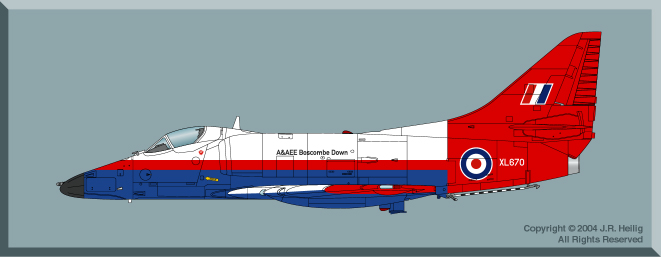 |
|
8. Skyhawk FG.2, XL670, A&AEE
Boscombe Down, 1988
In 1986 the “Superhawk” program got underway in
earnest. XL670 was chosen to be the pattern aircraft for most
of the upgrades. It is shown here in basic FG.2 configuration,
but with the radome for the APG-65 radar – not to mention the
Raspberry Ripple colors! The upper fuselage was white. Aft
fuselage, cheatline, and upper and lower wingtips were Ident
Red. Lower fuselage and lower inboard wings were Oxford Blue.
Serials under wings were white. All roundels had a white outer
border. |

HyperScale is proudly supported by
Squadron.com
Click return to go to Part One
Upgrades and Improvements 1983-1995
|
The Superhawk Program
After the Falklands there was a concerted
effort to address the many shortcomings of the Skyhawk in the modern
combat arena. While the Argentines may not have represented the
most up to date threat, other potentially hostile nations certainly
did, and the RN established a comprehensive program to modernize its
Skyhawk fleet. This program, managed by British Aerospace, was
given the overall name of Superhawk, although in practice the name
was (and is) rarely used.
One major item for which pilots fervetly wished
was a radar. The American Hughes APG-65 was chosen for the Skyhawk,
this unit having the advantage of being integrated into the Skyhawk
by several other operators such as Singapore and New Zealand. The
APG-65 represented the most modern radar available, with the
advantage that it would fit easily into the limited space available
in the nose of the Skyhawk. A new nose radome was fitted,
shortening the overall fuselage length by several inches.
|
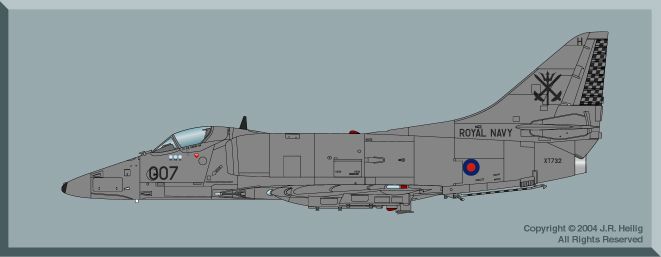 |
|
9. Skyhawk FG.2, XT732, 801
Squadron, HMS Hermes, 1989
Prior to the FA.6 upgrade, the entire Skyhawk fleet was
painted in this overall Medium Sea Grey scheme. All markings
were black, and no underwing serials were carried. Roundels
were small size tactical style. XT732 was one of the more
successful Skyhawks in the Falklands, bagging three Argentine
aircraft. Note the three roundels below the windscreen.
|
Other improvements implemented under this
program were a new wide field HUD, Martin-Baker Mk.10 seat, modern
Mil Std 1554 databus, GPS navigation, an infra-red search & track
system (IRST), RHAW and internal ECM gear, and most importantly, the
retrofit of a General Electric F404 engine. This last improvement
nearly doubled the available thrust, giving the second generation of
Royal Navy Skyhawk pilots an aircraft with a thrust-to-weight ratio
better than some of the most modern types in the world.
Weapons integrated into the new system included
all of the modern generation of GPS and laser guided munitions,
although a self-designating system for the laser guided weapons was
still sorely needed. The AIM-9L was still among the air-to-air
weapons fitted, but integration of the new AIM-9X and ASRAAM were
possible, and will likely be seen in the near future.
To the 21st Century
In addition to all these improvements, a new
one-piece windscreen and a bulged cockpit canopy were fitted. This
gives Skyhawk pilots a far better chance to see the enemy before
being seen themselves. This upgrade, plus the total tear-down and
rebuild of the airframes themselves, capped off a major series of
improvements to this amazing aircraft.
|
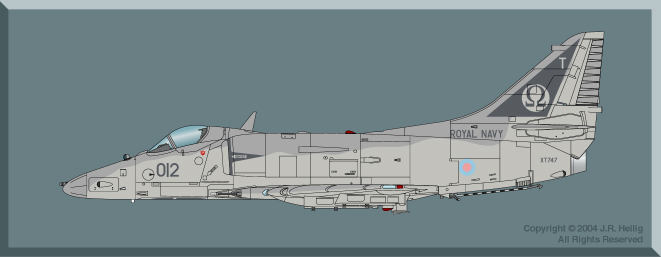 |
|
10. Skyhawk FA.6, XT747, 825
Squadron, HMS Triumphant, 1998
XT747 represents the latest configuration and color
scheme for the Skyhawk in RN service. Colors are commonly known
as Dark and Light Skyhawk Grey, and are used on no other RN
aircraft. Markings are mostly in EDSG, with pink and light blue
roundels on the fuselage and upper left wing only. |
The designation of these upgraded “Superhawks”
is Skyhawk FA.6, and they appear to be set for continued service
from the Royal Navy’s four modern fleet carriers well into the 21st
Century.
Trainer Skyahwk
Initially there was no two-seat training
variant of the Skyhawk. The U.S. Navy felt that the aircraft was
simple enough that a trainer was not necessary. By the mid-1960s
however, the forgiving nature of the A-4 and its ready adaptability
meant that a dedicated trainer was in the offing. The TA-4F/J
became the USN’s main carrier trainer, and it was only natural that
the RN would require some “two-holers” for its Skyhawk operations as
well.
|
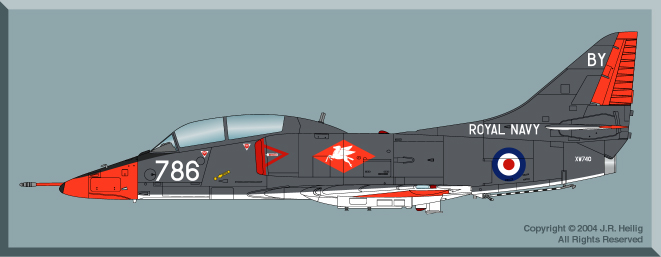 |
|
11. Skyhawk T.3, XW740, "Pegasus"
Aerobatic Team, Brawdy, 1970
XW740 was the #10 aircraft of the Royal Navy Pegasus
aerobatic team. The nine single seaters performed awe-inspiring
routines throughout the world in the late 1960s and early ‘70s,
delighting crowds wherever they went. This T.3 was somewhat
unusual in having glossy white lower surfaces. There were
extensive amounts of day-glo red-orange applied. In later years
it appeared in full Pegasus team colors prior to being converted
to a TT.4 in 1980.
|
While the USN used the TA-4 widely in the
carrier qualification role, the Royal Navy did not. The TA-4, known
in the RN as the Skyhawk T.3, was only used as a land-based
trainer. Center of gravity considerations prevented it from being
operated from the RN’s smaller ships. In addition, the trainer was
widely used by the RN in secondary roles such as target facilities
flights, aeromedical research, and station “hacks.” The GA.5
operated by the Fleet Requirements Air Direction Unit (FRADU) are
some of the more unique Skyhawks in that they dispense with the
refuelling boom and replace the radome in the nose with a Harley
Light, giving them a strange blunt-nosed appearance.
As noted previously, the RN’s Skyhawks have
worn a variety of color schemes and markings over the 45 years they
have been in service. Initially delivered in overall anti-flash
white with subdued pink/light blue markings, the FG.1s and early
FG.2s were repainted into a scheme of glossy Extra Dark Sea Grey
uppers and glossy white lowers with a high demarcation line on the
fuselage. Full color roundels and markings were the norm, although
there were minor variations in the position of the color demarcation
and in the way side numbers and other markings were treated between
the two variants.
In the late 1960s the EDSG was extended to
cover the entire airframe, with full color roundels and markings
retained. Some aircraft at this period had light blue Royal Navy
titles and underwing serials applied, and some squadrons used light
blue for side numbers as well. In the mid-1970s the EDSG was
changed to a semi-matte, and by the late 1970s roundels had switched
to the red/blue tactical style.
|
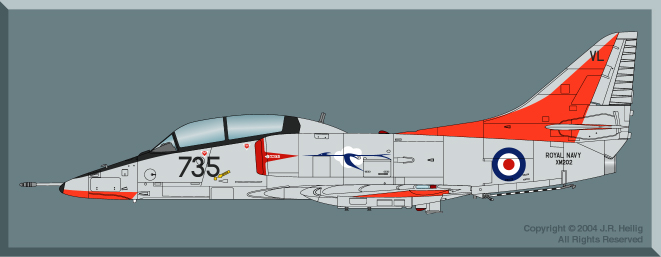 |
|
12. Skyhawk T.3, XM202, Heron
Station Flight, Yeovilton, 1972
One of the T.3s delivered in a non-standard color
scheme from the factory, XM202 spent its entire life as a
station aircraft. Seen here in 1972, it was in High Speed Silver
overall, with large areas of day-glo red-orange. The anti-glare
around the canopy was black.
|
In 1980 some Skyhawks appeared from rework
sporting glossy camouflage once again, with white undersides (with
black serials) and full color markings. This scheme was
short-lived, giving way to overall EDSG with no squadron markings,
and with modified roundels for service in the Falklands. Aircraft
painted in this scheme invariably had their underwing serials and
roundels overpainted, and their serials and the last two digits of
the side number were repainted in black in their original
locations. All other markings were obliterated.
After the hostilities in the South Atlantic
were over, Skyhawks appeared with overall Medium Sea Grey
camouflage, with most markings in black. Much smaller red/blue
tactical roundels appeared, and underwing serials were omitted
entirely. This was the final scheme in which most FG.2s were seen
as such.
|
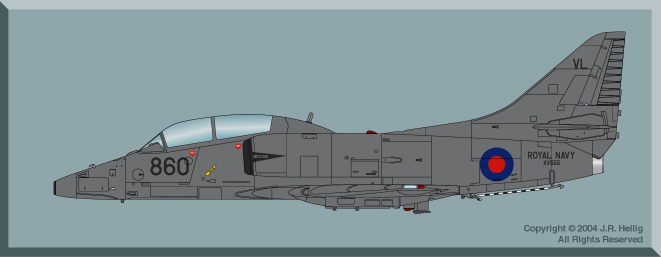 |
|
13. Skyhawk GA.5, XV555, FRADU,
Yeovilton, 1986
Six T.4s were converted to GA.5s when their refuelling
booms were removed and a high powered Harley Light fitted to the
truncated nose. They were (and continue to be) operated by
FRADU at Yeovilton. The aircraft is overall Dark Sea Grey with
a all markings in black. Tactical style roundels in six
standard positions.
|
With the advent of the FA.6 upgrade program, an
entirely new camouflage scheme with two new greys was introduced
fleet-wide. The colors did not originally have official names, but
common usage has begun to refer to them as Dark and Light Skyhawk
Grey. The scheme features a false canopy on the lower fuselage, and
this varies from black to EDSG to Dark Sea Grey, depending on the
airframe involved. Markings are generally applied in EDSG, and most
recent aircraft have reverted to the 1980s style RAF subdued pink
and light blue roundels.
|
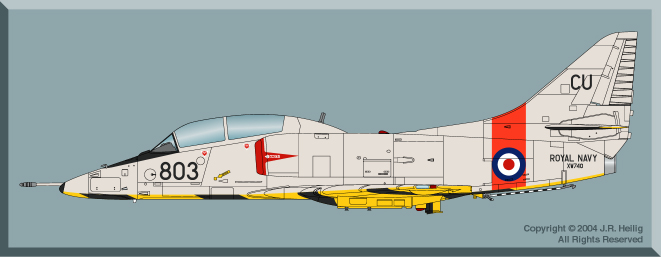 |
|
14. Skyhawk TT.4, XW740, Culdrose
Target Flight, 1990
The classic RN target tow scheme looks particularly
attractive on the Skyhawk. The entire upper surface is glossy
Light Aircraft Grey. The lower surfaces are Trainer Yellow with
black diagonal bands, and there is a day-glo red-orange band
around the aft fuselage. Culdrose only hosted a Target Flight
for a few years, with the aircraft moving back to (you guessed
it…) Yeovilton in 1992. |
Colors and markings applied to the T.3 and its
derivatives varied widely. A few aircraft were delivered directly
to second line units, and thus left the factory in the then-standard
scheme for the mission assigned, such as target towing, etc. Most
were delivered in overall EDSG however.
|
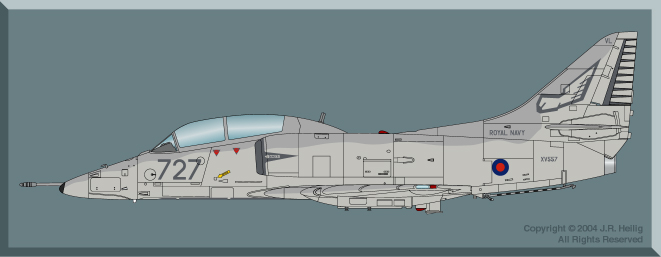 |
|
15. Skyhawk T.3, XM557, 899
Squadron, Yeovilton, 1995
This T.3 shows a slight variation on the current
camouflage scheme, notably in having full color tactical
roundels instead of the pink and light blue version. Otherwise
it is representative of T.3s assigned to the front line
squadrons for use as instrument trainers and hacks (and for
those public lottery rides!). |
One aircraft stood out from the rest of the RN
Skyhawk family. FG.2 XL670 was used as the pattern aircraft for the
FA.6 program, and during its tenure at the Armament & Aircraft
Experimental Establishment at Farnborough it was painted in the MoD
(PE) “Raspberry Ripple” scheme.
The Skyhawk has earned a place near and dear to
the hearts of everyone in the Royal Navy who has ever had anything
to do with it or its operations. Through nearly 45 years of
constant operations the Skyhawk has never ceased to be a stellar
performer, and has earned its stripes in battle over the South
Atlantic.
|
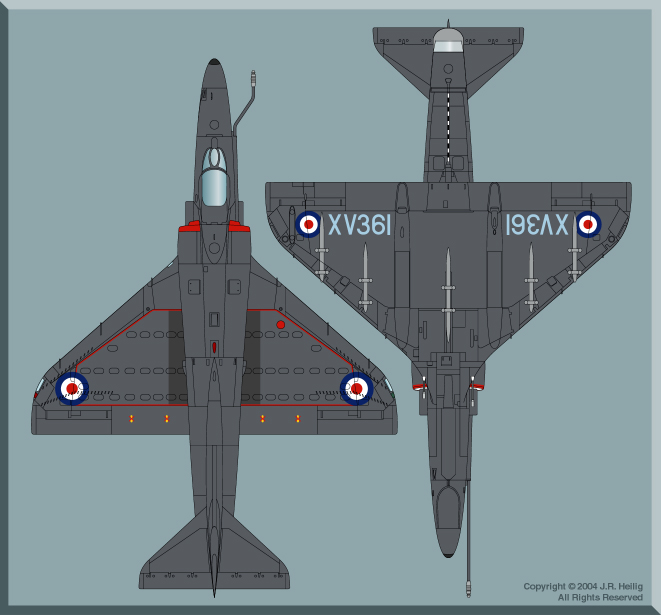 |
|
16. Skyhawk upper & lower
surface markings
This view shows typical sizes and locations of markings
for most of the life of the RN’s Skyhawks. Upper wing roundels
are 30” diameter, while lower wing roundels are 24”. Serials
are 18” high letters and numbers. |
With the current upgrade programs already
implemented and planned for the future, the career of the Skyhawk in
RN service appears set to go on for some considerable time yet.
Current plans call for the last squadron (believed to be 825
Squadron, as noted by their Omega tail symbol) to remain operational
until sometime around 2020. By that time the newest airframe will
be well past its 50th birthday, but undoubtedly still
going strong.
FG.1 production:
XJ201 through XJ233 (XJ201/203 were Douglas
built) (33 aircraft)
XK425 through XK442 (18 aircraft)
Total FG.1: 51 aircraft
FG.2 production:
XL660 through XL671 (12 aircraft)
XM390 through XM394 (5 aircraft)
XT727 through XT747 (20 aircraft)
XV358 through XV378 (20 aircraft)
Total FG.2: 57 aircraft
T.3 production:
XM200 through XM204 (5 aircraft)
XV555 through XV559 (5 aircraft)
XW735 through XW746 (12 aircraft)
Total T.3: 22 aircraft
Total Hawker Siddeley production:
127 aircraft (plus 3 from Douglas)
Text and Images Copyright © 2004 by
Jennings Heilig
Page Created
17 June, 2004
Last updated
12 August, 2004
Back to HyperScale Main
Page
Back to Reviews
Page
|
Home |
What's New |
Features |
Gallery |
Reviews |
Reference |
Forum |
Search